Last Updated on January 18, 2024 by teamobn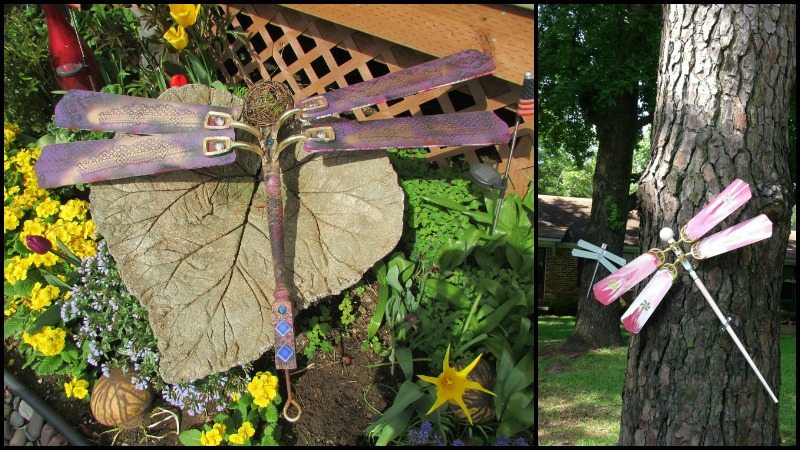
Let giant dragonflies invade your garden or yard by upcycling old ceiling fan blades! This outdoor decor is sure to make passers-by take a second look. Fortunately creating your own DIY Dragonfly yard art can be done easily.
Don’t have an old ceiling fan? Why not search your local thrift store? And while you’re there, go look for a straight but carved table leg because you’ll be needing it, too!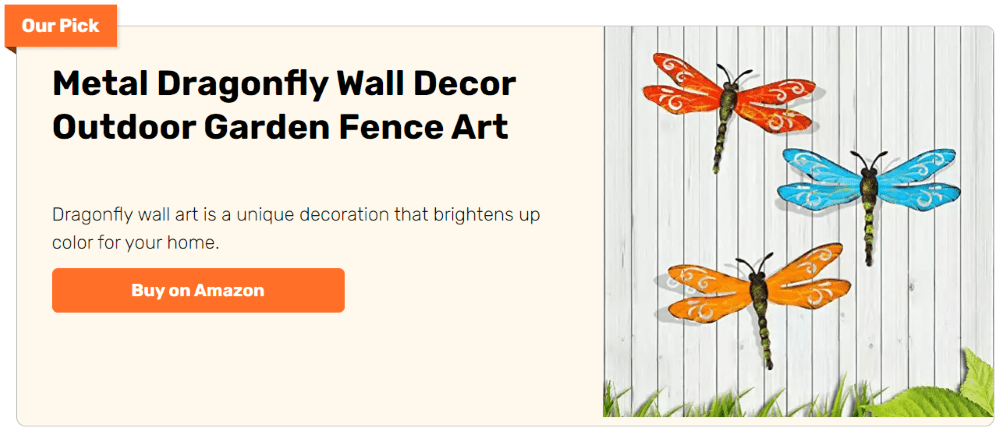
Old ceiling fans are often in danger of falling due to the age of their motor. If you have any old ceiling fans around your home, make sure the motor is in good working order. If the motor is starting to make noises or is making strange sounds, then you should consider replacing it.
When replacing your old ceiling fans, consider installing new energy-efficient models. These fans can help save energy costs for your home and reduce your carbon footprint. So what will you do with the old ceiling fan you just replaced?
Well, creating a giant dragonfly using the old ceiling fan blades will be a sure head-turner in your backyard, or wherever you decide to place it.
This is a great upcycling project where you can also make use of certain scrap materials that seem, well, useless. You can take small, excess tiles, pebbles — any trinkets — to add detail to your dragonfly.
Yes — it will also look great as indoor decor for big empty walls!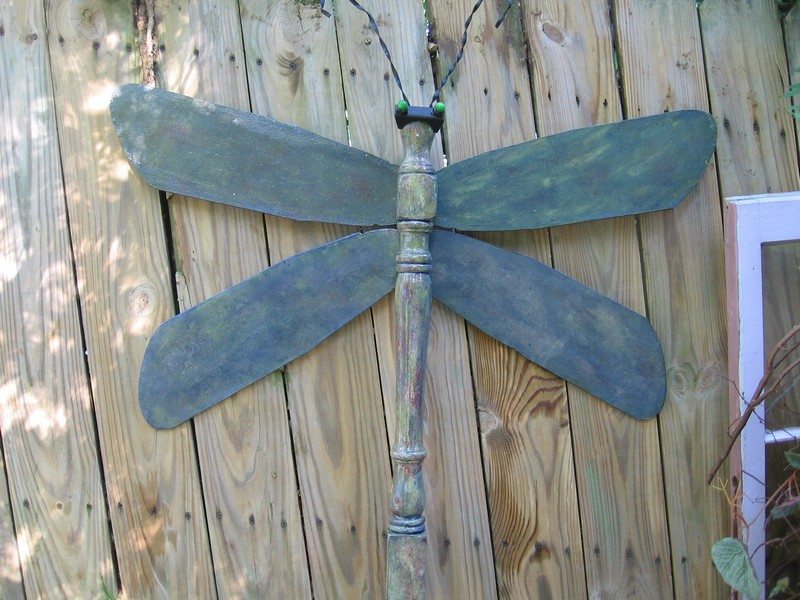
Many different cultures view the dragonfly as a symbol of transformation, growth, healing, and good luck. In the Buddhist culture, dragonflies represent the perfect balance of masculine and feminine energies.
The Hindu culture believes the dragonfly to be the symbol of everlasting love and the Slavic culture associates dragonflies with the souls of the dead. In several cultures, dragonflies also represent the “thousand-eyed god,” which is called Argus Panoptes in Greek mythology.
This is why using it as a decorative will serve its purpose! A beautiful and mystic decorative!
Take a look at some beautiful examples of ceiling fan blades from various DIY-ers through the gallery below and be inspired to make your own.
Contents
- 1 Giant DIY dragonfly ideas.
- 2 How to Build Your DIY Dragonfly Yard Art
- 3 Design and Decoration Tips
- 4 Placement and Care
- 5 FAQ for Dragonfly Yard Art Article
- 5.1 What materials work best for making dragonfly yard art?
- 5.2 Can I leave my dragonfly yard art outside all year?
- 5.3 How do I secure the dragonfly yard art in my garden?
- 5.4 What kind of paint should I use for my dragonfly yard art?
- 5.5 How often should I maintain my dragonfly yard art?
- 5.6 Is it difficult to make dragonfly yard art?
- 5.7 Can I customize my dragonfly yard art?
- 5.8 What should I do if the wings on my dragonfly yard art become loose?
- 6 Conclusion
Giant DIY dragonfly ideas.
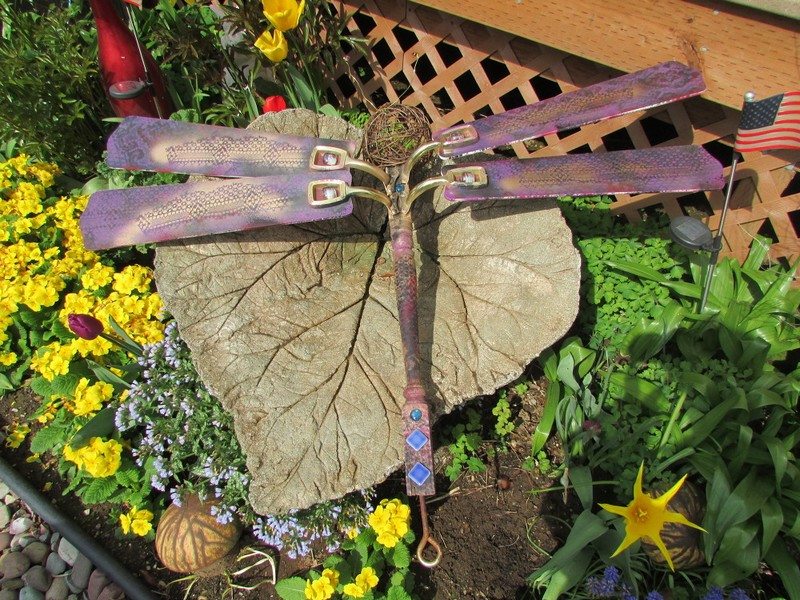
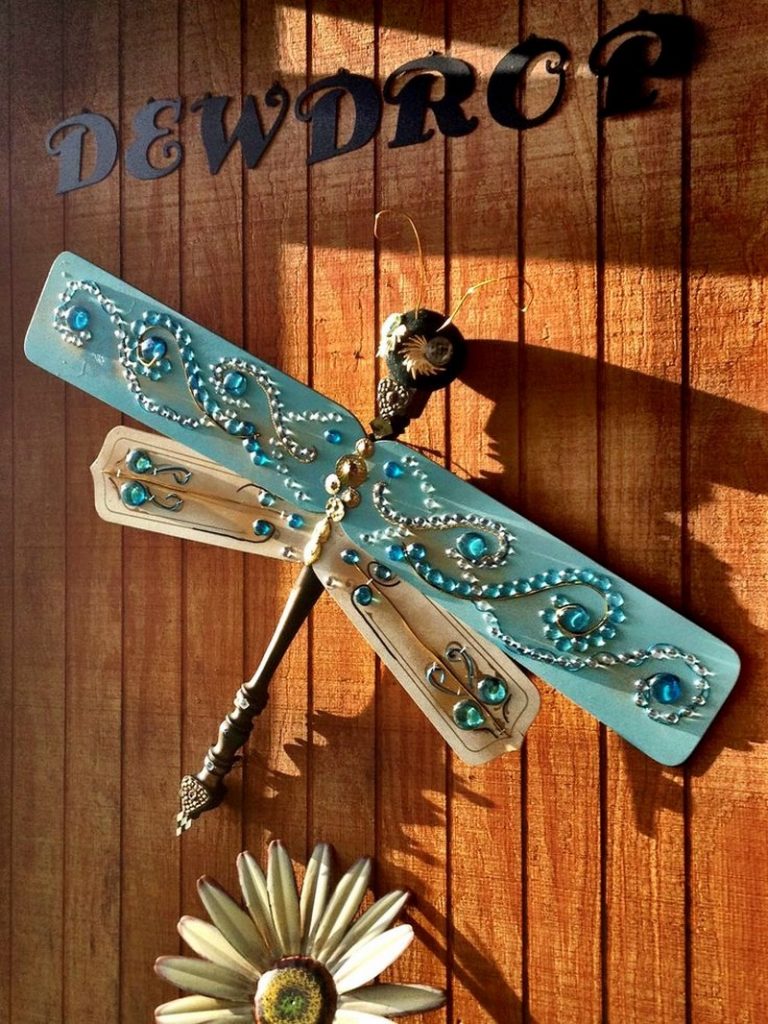
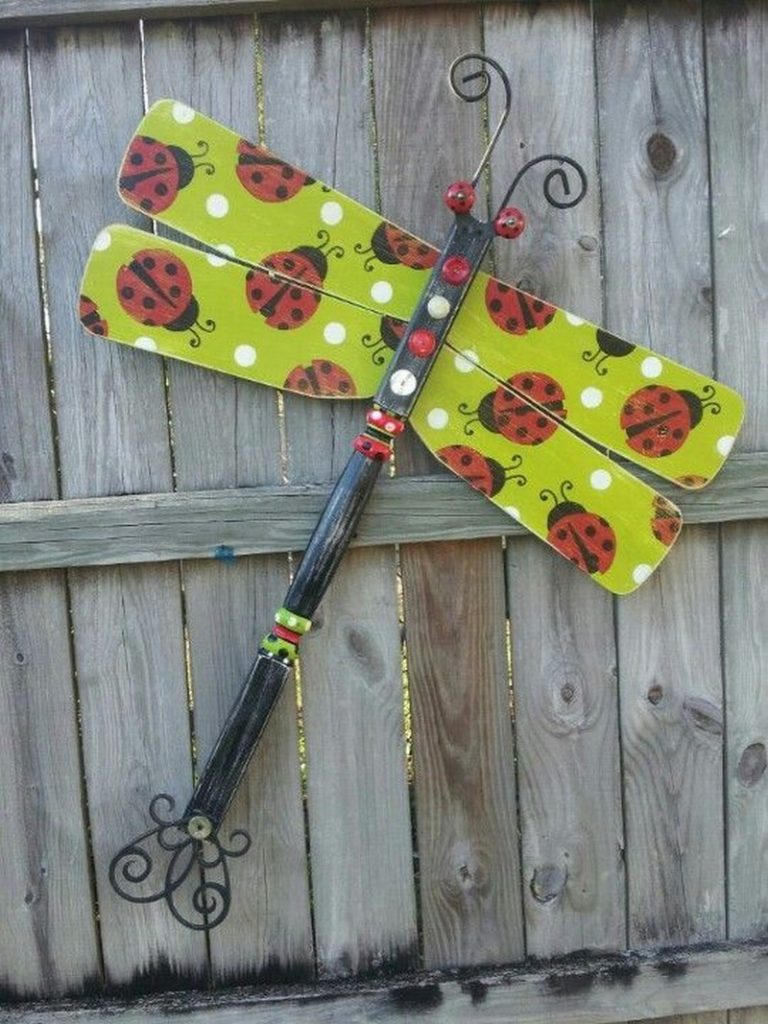
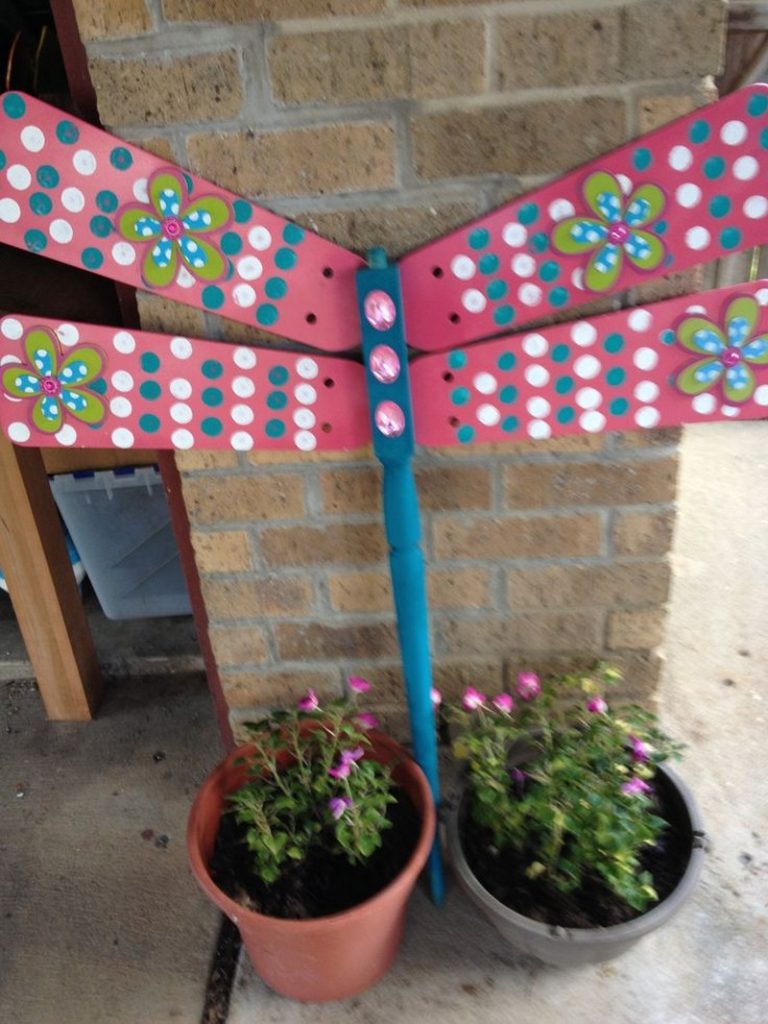
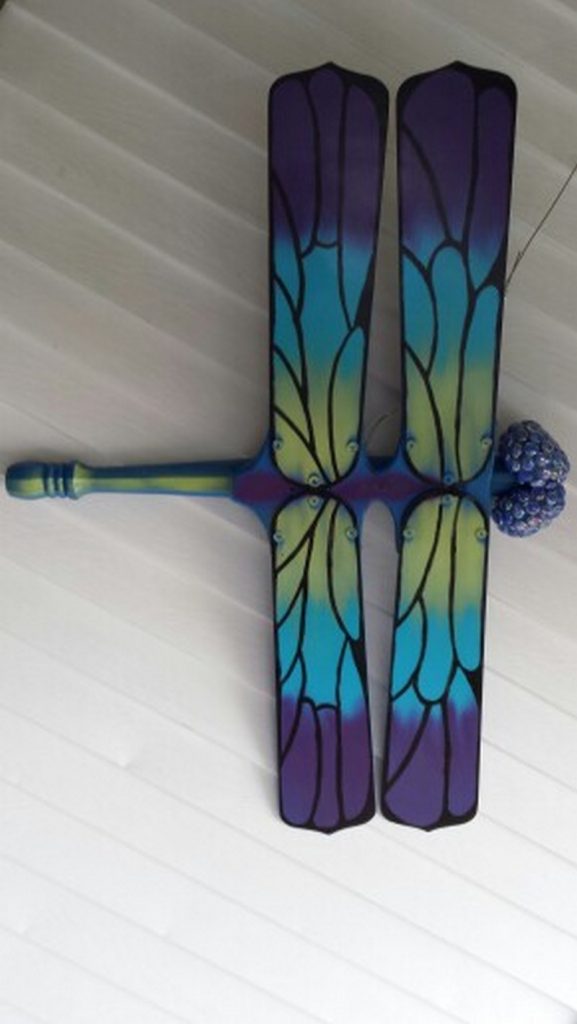
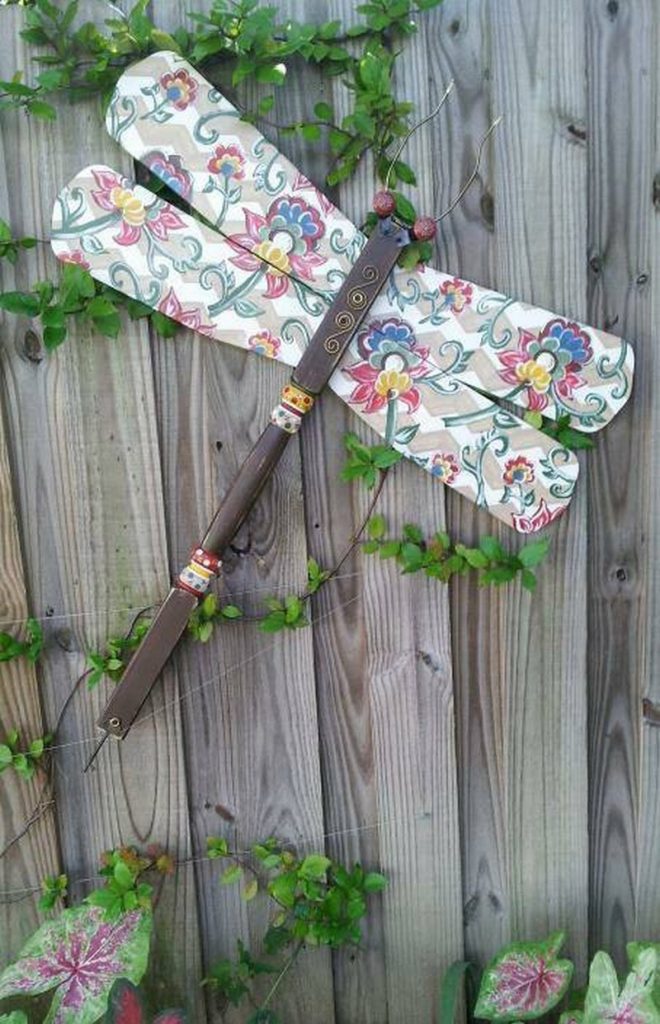
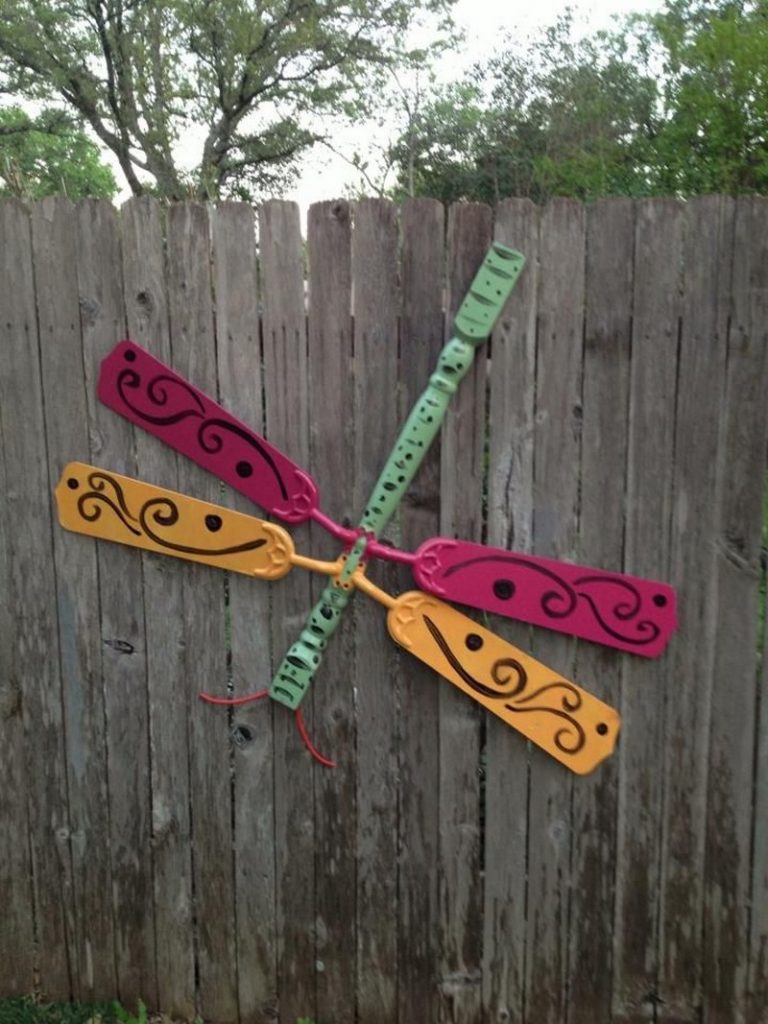
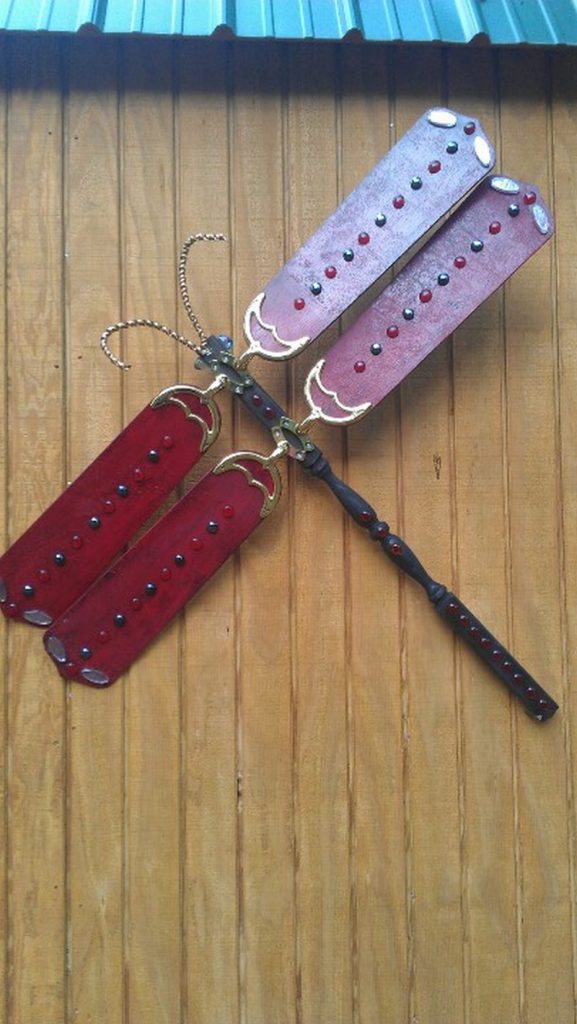
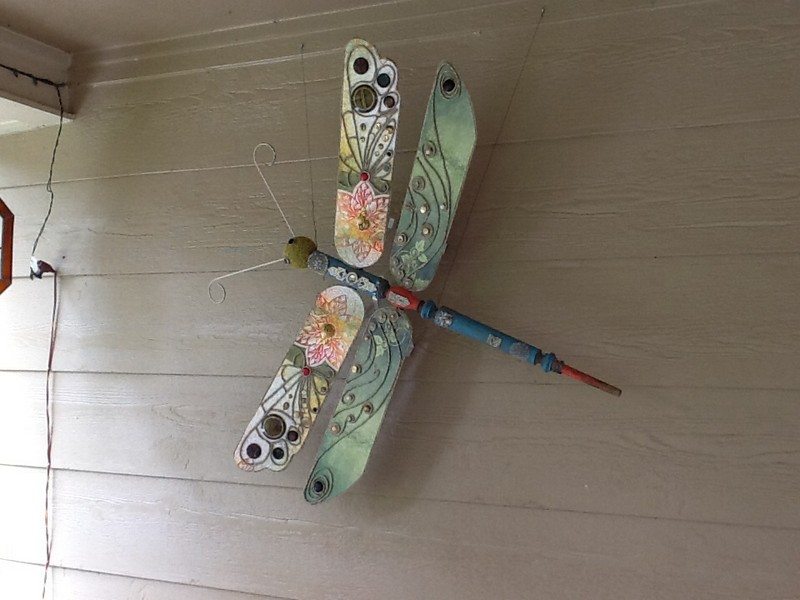

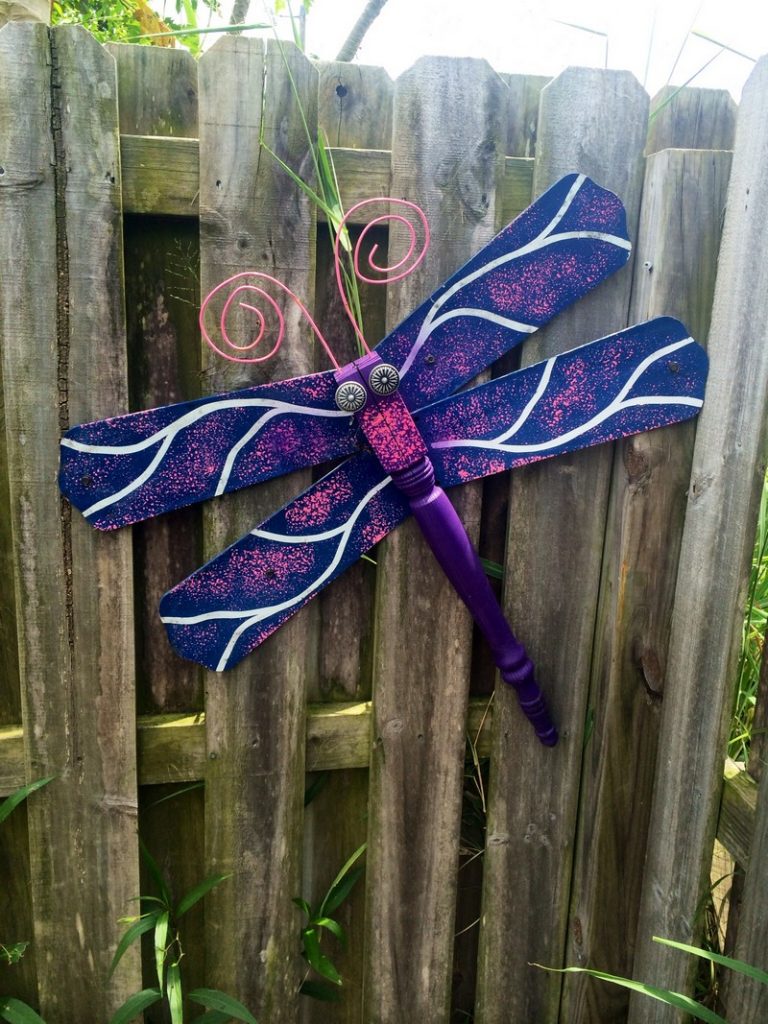
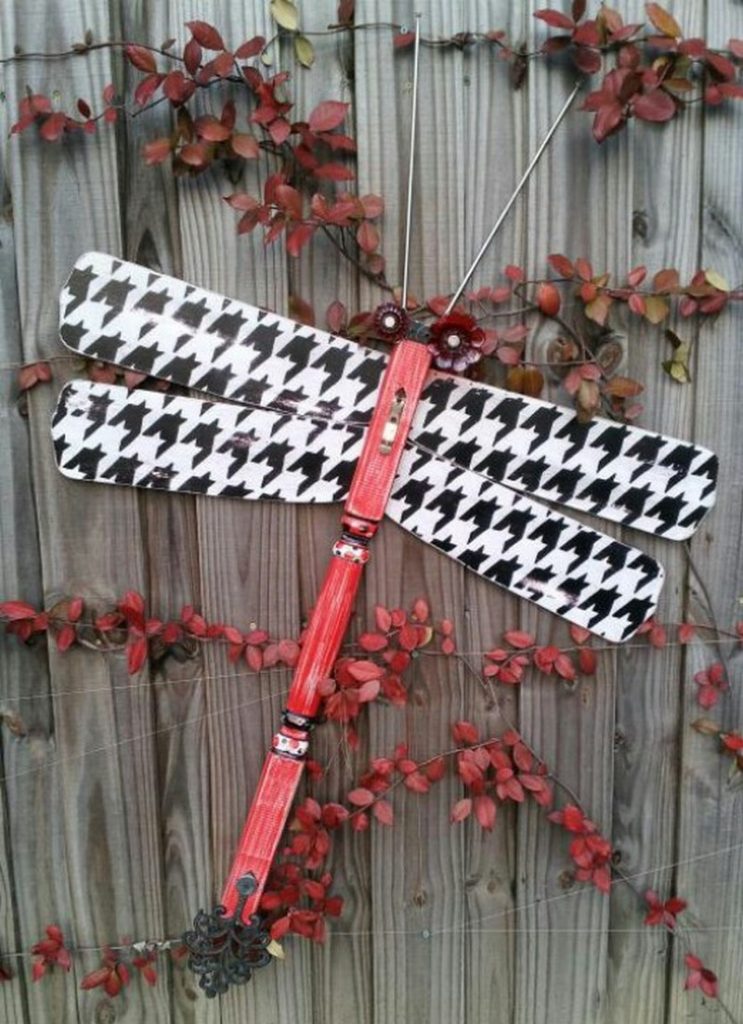
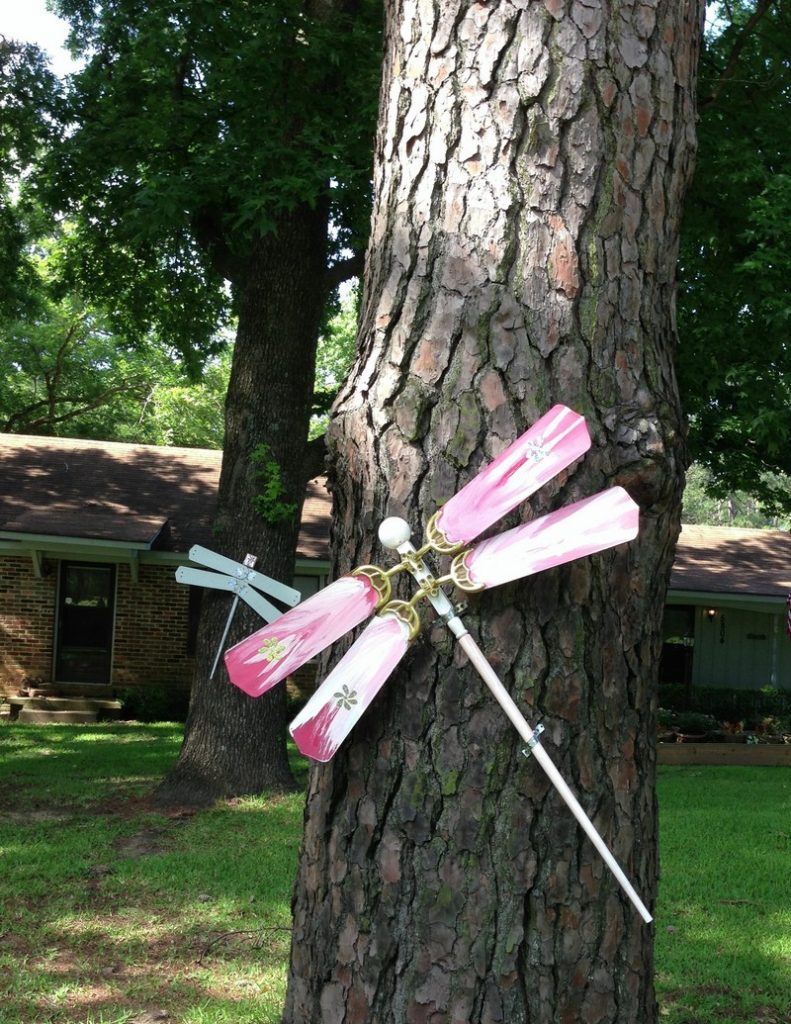
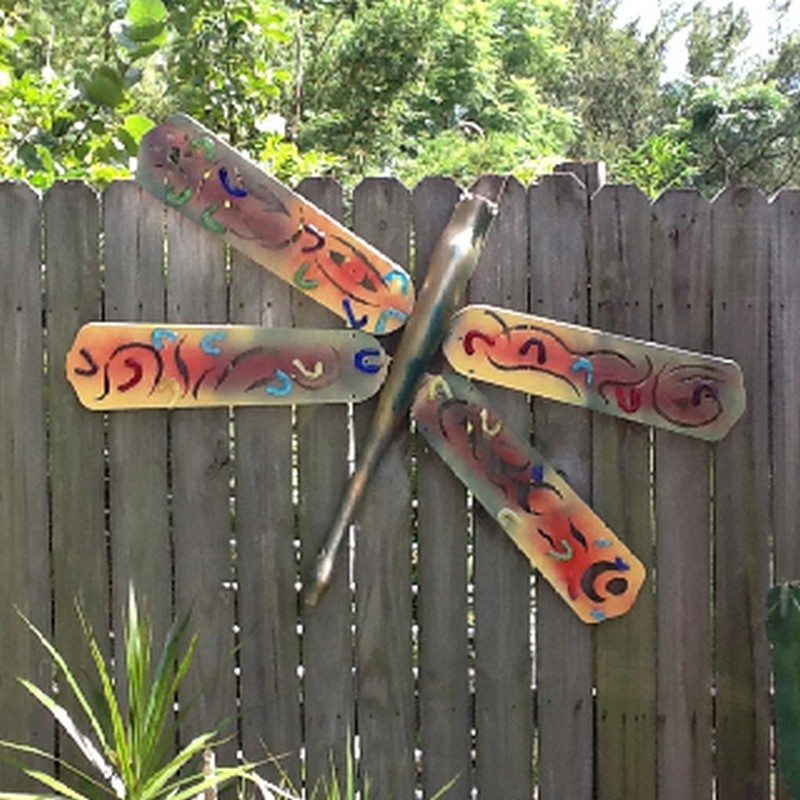
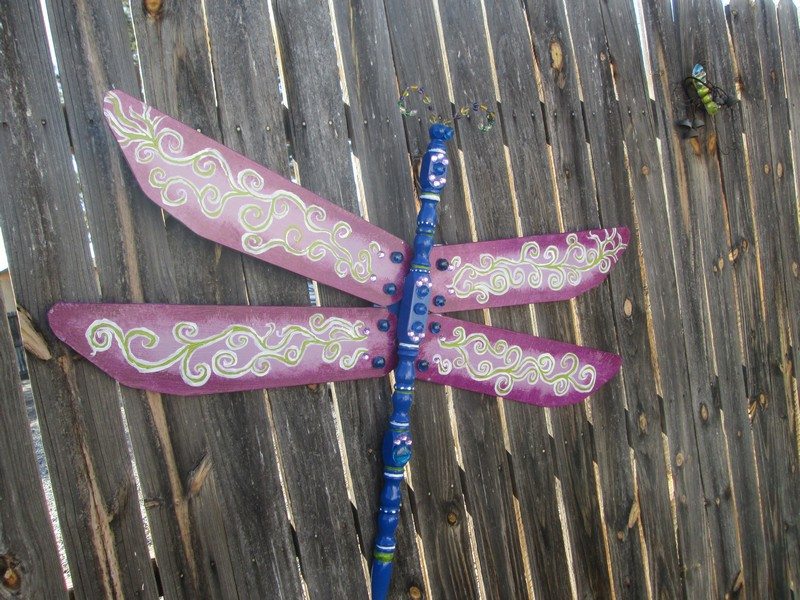
How to Build Your DIY Dragonfly Yard Art
Materials:
- Old Newspaper (for covering work area)
- Old Ceiling Fan Blades
- Table Leg
- Gate Hook
- Twig Ball (or any material you can use as the head)
- Spray Paint
- Lace (or any other materials for designing the dragonfly)
- Masking Tape
- Screws
- Protective Mask
- Wires (optional, for feet)
Tools:
- Drill
- Pliers
Step-by-Step Guide
Preparing the Workspace and Materials
- Cover your work area with old newspapers to protect surfaces.
- Gather the old ceiling fan blades, a table leg, gate hook, twig ball, spray paint, lace, masking tape, screws, protective mask, and wires if you’re using them.
Assembling the Dragonfly Body
- Start by preparing the table leg, which will serve as the dragonfly’s body. If needed, cut it to your desired length.
- Attach the gate hook to one end of the table leg. This will be where the head attaches.
Creating the Head
- Take the twig ball or chosen material for the head. If it’s not already, paint it with spray paint.
- Once dry, attach the head to the gate hook on the table leg.
Attaching the Wings
- Position the ceiling fan blades to resemble dragonfly wings. Two blades on each side work well.
- Use the drill to create holes where the wings will attach to the body.
- Secure the wings to the body using screws. Ensure they are tightly fixed.
Adding Decorative Elements
- Use lace or other materials to add decorative details to the wings. Masking tape can help position them before fixing.
- If desired, paint over these materials with spray paint for a cohesive look.
Creating and Attaching the Feet (Optional)
- If adding feet, use pliers to shape wires into feet.
- Drill small holes at the bottom of the body to attach the wire feet.
- Insert and secure the wire feet with screws or by bending the wire inside.
Final Touches
- Once fully assembled, add any additional paint or decorative elements.
- Let the dragonfly dry completely before moving it to its display location.

Design and Decoration Tips
Creating dragonfly yard art from upcycled materials is not just eco-friendly; it’s also a chance to express your creativity. These tips will help you enhance the beauty and uniqueness of your dragonfly yard art.
Choose a Color Scheme
Complement Your Garden’s Palette
- Vibrant Colors: If your garden is full of life and color, choose bright and bold colors for your dragonfly yard art. Think of vivid blues, greens, or even purples to mirror the vibrancy of flowering plants.
- Earthy Tones: For gardens with a more natural or rustic feel, opt for earthy tones. Soft greens, browns, and beiges can make your dragonfly blend seamlessly into its surroundings.
Seasonal Considerations
- Spring and Summer: Lighter, brighter colors work well for these seasons. Consider pastel shades or warm colors that reflect the season’s energy.
- Fall and Winter: Darker, richer colors can complement the more subdued tones of these seasons. Deep reds, oranges, and yellows can mimic the changing leaves and add warmth.
Reflecting Personal Style
- Your Favorite Colors: Don’t forget to incorporate your favorite colors. If you have a preference for certain shades, use them to add a personal touch to your dragonfly yard art.
- Experiment with Combinations: Mix and match different colors to find a unique combination. Contrasting colors can create a striking effect, while analogous colors offer a harmonious look.
Adding Patterns and Textures
Incorporating patterns and textures into your dragonfly yard art can elevate its visual appeal. Here are some ways to do this effectively:
Using Lace for Intricate Designs
- Lace Overlays: Apply pieces of lace over the wings before painting. Once the paint is dry, remove the lace to reveal a detailed, intricate pattern.
- Layering: Layer different types of lace or combine it with other materials to create unique textures.
Stencils for Precision and Variety
- Homemade Stencils: Create your own stencils from cardboard or plastic sheets. This allows for custom designs that are unique to your dragonfly yard art.
- Multiple Patterns: Use different stencil patterns to add variety. Consider geometric shapes, natural motifs, or abstract designs for a dynamic look.
Natural Textures with Leaves
- Leaf Imprints: Place leaves on the dragonfly’s wings and spray paint over them. Once the paint dries and you remove the leaves, you’ll have beautiful leaf imprints.
- Variety of Leaves: Experiment with different types and sizes of leaves. This can create a more organic, natural pattern on your dragonfly yard art.
Textured Paint Techniques
- Sponge Painting: Use a sponge to dab paint onto the wings. This creates a textured, layered look.
- Dry Brushing: Lightly drag a dry brush over the surface. This technique highlights raised details and adds depth.
By adding patterns and textures, you transform the dragonfly yard art into a captivating piece of art. Experiment with these techniques to find the perfect combination for your garden.
Personal Touches
Adding personal touches to your dragonfly yard art can transform it from a simple decoration to a meaningful piece that reflects your individuality. Here’s how to infuse your personal style:
Incorporating Glass Beads
- Colorful Accents: Use glass beads in colors that complement or contrast with your dragonfly’s overall color scheme. They can be embedded into the wings or body for a pop of color.
- Patterns with Beads: Create specific patterns or designs with the beads. This could be anything from simple dots and lines to more complex shapes like flowers or stars.
Using Mosaic Tiles
- Mosaic Wings: Cover the wings with small mosaic tiles to create a stunning, detailed effect. You can use broken pieces of colored glass or pre-cut mosaic tiles.
- Themed Designs: Think about a theme or motif for your mosaic. This could be a natural scene, abstract patterns, or geometric shapes.
Reflective Elements with Mirrors
- Small Mirrors for Sparkle: Attach small mirrors to catch the light and add a sparkling effect. This works especially well on the wings and body of the dragonfly.
- Mirror Patterns: Arrange the mirrors in specific patterns or shapes to add another layer of design to your dragonfly yard art.
Unique Embellishments
- Personal Items: Incorporate items that have personal significance. This could be anything from a piece of jewelry to a small charm.
- Nature-Inspired Elements: Add natural elements like small stones, shells, or dried flowers for an organic touch.
Remember, the key to personalizing your dragonfly yard art is to express your own style and preferences. Use these suggestions as a starting point and let your creativity guide you to create a truly one-of-a-kind piece.
Placement and Care
Proper placement and care are essential to ensure your dragonfly yard art remains a stunning feature in your garden for years to come. Here are some tips to help you achieve this:
Maximizing Visibility
- Pathways and Entrances: Position your dragonfly yard art near garden paths or entrances. This makes it a welcoming focal point for visitors.
- Amongst Flowers: Placing it near flower beds creates a natural habitat look. The colors of the flowers can complement the dragonfly yard art.
- Near Water Features: If you have a pond or a fountain, placing the dragonfly yard art nearby can create a thematic setting, as dragonflies are often found near water.
Optimal Sunlight Exposure
- Morning Light: Try to position your dragonfly yard art where it will receive morning sunlight. The softer light can make the colors glow without the intensity of midday sun, which might fade the colors over time.
- Sunlight Reflection: If your dragonfly yard art has reflective elements like glass or mirrors, place it where the sunlight can enhance these features, creating a sparkling effect.
Protecting from Wind
- Sheltered Areas: Look for areas in your garden that are sheltered from strong winds. This could be near a wall, fence, or dense shrubs.
- Check for Overhanging Branches: Ensure there are no loose branches above the chosen spot, as they could fall and damage the dragonfly yard art during windy conditions.
- Secure Installation: Regardless of the location, make sure your dragonfly yard art is installed securely. This will minimize the risk of damage from moderate winds.
Stable Mounting
- Ground Installation: If your dragonfly yard art is designed to be staked into the ground, choose a spot where the soil is firm enough to hold it upright. Avoid soft, marshy, or overly sandy areas where the stake might shift or sink.
- Depth of Insertion: Insert the stake deep enough into the ground to provide stability, but be mindful of underground utilities or irrigation systems.
- Wall-Mounted Art: For dragonfly yard art that is to be mounted on a wall, use durable hooks or fixtures. Ensure they are appropriate for the wall material, whether it’s brick, wood, or siding.
Checking Stability
- Routine Checks: Periodically, give your dragonfly yard art a gentle shake to ensure it remains firmly in place. This is especially important after extreme weather conditions like heavy rain or wind.
- Secure Fastenings: Check all fastenings, screws, or bolts. Tighten any that have become loose over time.
- Reinforcement if Necessary: If your dragonfly yard art begins to wobble or lean, consider reinforcing it. This might mean adding additional stakes, using larger screws, or even repositioning it to a more sheltered location.
Regular Cleaning
- Frequency of Cleaning: Depending on your location and the season, clean your dragonfly yard art every few weeks to prevent build-up of dirt and debris.
- Soft Cleaning Approach: Use a soft brush or cloth to gently wipe the surface. For more stubborn dirt, use a mild detergent mixed with water and rinse thoroughly.
- Avoid Harsh Chemicals: Stay away from strong cleaning agents as they can damage the paint and materials.
Paint Touch-Ups
- Monitoring Paint Condition: Keep an eye out for any chipping or fading. Exposure to sunlight and weather can affect the paint over time.
- Color Matching: When doing touch-ups, try to match the original color as closely as possible. Test the paint on a small, inconspicuous area first.
- Proper Application: Ensure the surface is clean and dry before applying paint. Use small brushes for precision and avoid over-painting.
Winter Care
- Storage Options: If possible, move your dragonfly yard art indoors during winter, especially in regions with snow and ice.
- Outdoor Winter Care: If you can’t move it indoors, cover it with a waterproof cover or tarp to provide some protection from the elements.
Periodic Inspections
- Regular Checks: Every few months, inspect your dragonfly yard art for any signs of wear, such as rust, cracks, or loose parts.
- Immediate Repairs: Address any issues as soon as they are noticed to prevent further damage.
Protective Coatings
- Choosing the Right Coating: Select a clear protective spray or varnish that is suitable for outdoor use and compatible with the materials of your dragonfly yard art.
- Application Process: Apply the coating evenly, following the manufacturer’s instructions. Make sure the art is clean and dry before application.
- Reapplication Frequency: Reapply the protective coating annually, or more frequently if your dragonfly yard art is exposed to harsh environmental conditions.
FAQ for Dragonfly Yard Art Article
What materials work best for making dragonfly yard art?
Can I leave my dragonfly yard art outside all year?
How do I secure the dragonfly yard art in my garden?
What kind of paint should I use for my dragonfly yard art?
How often should I maintain my dragonfly yard art?
Is it difficult to make dragonfly yard art?
Can I customize my dragonfly yard art?
What should I do if the wings on my dragonfly yard art become loose?
Conclusion
Creating dragonfly yard art from upcycled materials is a fulfilling and creative project. It not only adds a unique touch to your garden but also promotes sustainable practices. By following the guidelines outlined in this article, you can transform old ceiling fan blades and simple household items into a stunning piece of art. The process is straightforward and allows for a lot of personalization, ensuring that each dragonfly yard art piece is as unique as the creator.
If you liked this project, you will also like viewing these recycled and repurposed ideas and DIY garden art ideas.






